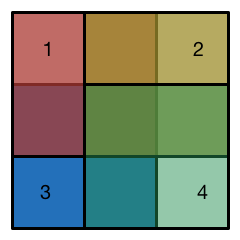Placing square on a grid - Part 3

On a 3 by 3 grid, the red, yellow, blue and green 2 by 2 squares are placed in some order. They have to be placed in their location (IE not moved somewhere else). There are different ways to place these squares.
Of these 24 different ways, how many distinct results would we get?
For example, placing 1432 and 4132 will both yield

No vote yet
1 vote
Easy Math Editor
This discussion board is a place to discuss our Daily Challenges and the math and science related to those challenges. Explanations are more than just a solution — they should explain the steps and thinking strategies that you used to obtain the solution. Comments should further the discussion of math and science.
When posting on Brilliant:
*italics*or_italics_**bold**or__bold__paragraph 1
paragraph 2
[example link](https://brilliant.org)> This is a quote# I indented these lines # 4 spaces, and now they show # up as a code block. print "hello world"\(...\)or\[...\]to ensure proper formatting.2 \times 32^{34}a_{i-1}\frac{2}{3}\sqrt{2}\sum_{i=1}^3\sin \theta\boxed{123}Comments
16.
I'll be referring to the 2 X 2 squares as numbers, and each of the 9 squares as blocks. First, look at the four corner blocks. They can only be covered by the number on it. So we can disregard those. We are left with a central cross. The center of this cross can be covered in 4 ways, since whichever number we choose first covers it. Now, we are left with the four other blocks. Of these, 2 will be covered by the first number we chose, so they don't matter. We are left with two blocks. Each of these blocks can be covered by two numbers and each choice is possible, so we have 4∗2∗2=16.
Log in to reply
I'm getting a total of 20, although your reasoning seems sound. As I understood the question the first number forms the bottom "layer", the second number the second layer and so on, so that the last number/color is on top. For the sequences that end in 23,32,14,41 it doesn't matter what the order of the first two layers is, so this produces 4 duplicates. For the other 8 possible pairs of top layers it will matter how the first two layers are chosen, so there are no duplicates here. Thus I get 24−4=20 sequences that produce distinct patterns. Where is the flaw in my logic?
Edit: O.k., I see now. 1324 gives the same result as 1234, 4321 gives the same result as 4231, 3142 gives the same result as 3412 and 2143 gives the same result as 2413. This gives us 4 more duplicates, leaving us with 16 distinct outcomes, as Siddhartha and Brock have found.
Wow, that's a nice analysis! It's certainly simpler than I thought it would be.
Nice approach. I did it in a similar manner too :)
I'm finding 16, gentlemen.
Python 2.7:
Log in to reply
Nice program, Brock. I can't argue with its output; the answer is indeed 16. :)
Log in to reply
Thanks! :D